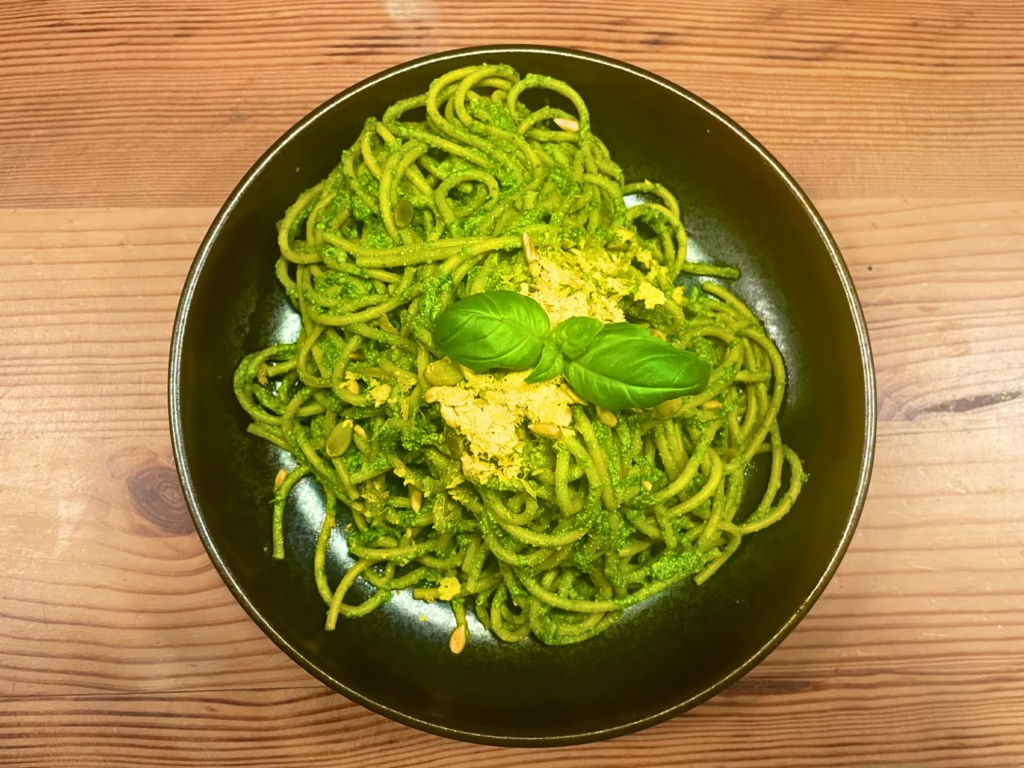Lately, everyone has been talking about the gut microbiome and recommending fermented foods. But what are fermented foods, and how can we incorporate them into our diets for maximum health benefits?
WHAT IS FERMENTED FOOD?
Fermented food is created with beneficial microorganisms, such as bacteria, yeasts, or moulds, which convert sugars and starches into acids, gases, or alcohol. This process not only enhances the flavour and shelf life but also provides health benefits, particularly for gut health, due to probiotics.
WHAT ARE SCIENCE BACKED BENEFITS OF FERMENTED FOOD?
Fermented foods offer a variety of health benefits, including improved digestive (1) and immune health (2), enhanced nutritional value(3), better metabolic health, potential weight management benefits(4), and positive effects on cognitive health(5). Eating fermented foods regularly can be very beneficial for your nutrition and your gut microbiome.
Most of us know yoghurt and kimchi are fermented foods, but there are way more that you can incorporate into your diet. I will compare 15 different fermented foods from around the world so you can choose the one that is right for your nutrition and dietary requirements and, of course, your taste buds.
FERMENTED VEGETABLES AND BREAD
1. Sauerkraut: Fermented cabbage with a tangy flavour originating from Germany. Commonly used as a condiment or side dish. It can also have carrots and cumin in it.
2. Kimchi: A staple in Korean cuisine, kimchi is made from fermented vegetables like cabbage and radishes and lots of spices—chili pepper, garlic, and ginger. It is typically vegan, but check the ingredients as it might sometimes contain fish souse, anchovies, or shrimp paste.
3. Miso: A traditional Japanese seasoning produced by fermenting soybeans with salt and fungus. It has an umami taste, and I use it in soups, sauces and marinades.
4. Tempeh: A fermented soybean with a firm texture and nutty flavour. I use it as a meat substitute as it is very high in protein.
5. Natto: A traditional Japanese food made from fermented soybeans, known for its strong flavour and sticky texture.
6. Sourdough Bread: It is made by fermenting dough using naturally occurring lactobacilli and yeast. It is known for its tangy flavour, chewy texture, and low Glycemic Index. You can read more about sourdough nutrition here.
7. Pickles are vegetables ( mostly cucumbers) fermented in a brine made of water, salt, and spices.
8. Idli and Dosa: Idli is a steamed cake, and dosa is a thin, crispy pancake made from fermented rice or lentils. Both originate from South India.
FERMENTED DRINKS AND SAUCES
9. Kombucha: A fermented tea drink with a natural fizz and sour taste. Made by fermenting sweetened tea with a symbiotic culture of bacteria and yeast (SCOBY). For more benefits of Kombucha, you can read here.
10. Kvass: A traditional Eastern European fermented beverage made from rye bread, known for its low alcohol content and sweet and sour taste.
11. Soy Sauce: made from fermented soybeans, wheat, salt, and water. Essential in many Asian cuisines. Look out for labels “traditionally brewed” or “naturally brewed.”
FERMENTED DAIRY
12. Yoghurt: Fermented dairy product made by adding bacterial cultures to milk.
13. Kefir: A fermented milk drink similar to yoghurt but with a thinner consistency and more diverse bacterial cultures.
14. Cheese: Many varieties of cheese are fermented, with specific bacterial cultures giving each type its unique flavour and texture. To maximize health benefits, always choose high-quality cheeses that specify the presence of live cultures.
FERMENTED fish
15. Fermented Fish: Various cultures have traditional fermented fish dishes, such as Swedish Surströmming, Japanese Shiokara, and Korean Hongeo.

FERMENTED FOODS COMPARISON TABLE
Here’s a comparison table of all 15 popular fermented foods, their main ingredients, probiotic content, and health benefits:
| Fermented Food | Probiotic Strains | Protein (per 100g/ml) | Calories (per 100g/ml) | Vitamins/Minerals |
|---|---|---|---|---|
| Sauerkraut | Lactobacillus, Leuconostoc | 1.3g | 27 | Vitamin C, Vitamin K |
| Kimchi | Lactobacillus, Leuconostoc | 1.1g | 15 | Vitamin A, Vitamin C |
| Miso | Lactobacillus, Pediococcus | 11.7g | 199 | Manganese, Vitamin K |
| Tempeh | Rhizopus, Lactobacillus | 19g | 193 | Iron, Calcium |
| Natto | Bacillus subtilis | 18.7g | 212 | Vitamin K2, Iron |
| Sourdough Bread | Wild yeast, Lactobacillus | 8g | 289 | B Vitamins |
| Pickles | Lactobacillus | 0.5g | 11 | Vitamin K, Vitamin C |
| Fermented Soy Sauce | Aspergillus, Lactobacillus | 5g | 53 | Iron, Manganese |
| Kombucha | Lactobacillus, Gluconacetobacter | 0.5g | 14 | B Vitamins |
| Kvass | Lactobacillus | 0.3g | 27 | Vitamin B, Vitamin C |
| Idli and Dosa | Wild yeast, Lactobacillus | 5g | 128 | Iron, Vitamin B |
| Yogurt | Lactobacillus, Bifidobacterium | 10g | 59 | Calcium, Vitamin B12 |
| Kefir | Lactobacillus, Bifidobacterium, Saccharomyces | 3.3g | 41 | Calcium, Vitamin B12 |
| Cheese | Varies by type | Varies by type | Varies by type | Calcium, Vitamin B12 |
| Fermented Fish | Varies by type | Varies by type | Varies by type | Omega-3s, Vitamin D |
We know that there are billions of good bacteria in fermented food, but let’s look into the most known ones. Here is a list of common probiotic strains found in various fermented foods, their purpose in food and their health benefits:
- Lactobacillus is one of the most common probiotic strains. It helps digest lactose, supports gut health by maintaining the balance of beneficial bacteria, and may help with conditions like diarrhoea and irritable bowel syndrome (IBS). Lactobacillus can also boost the immune system.
- Bifidobacterium breaks down dietary fibre, produces vitamins, and prevents infection by harmful bacteria. These probiotics are often used to treat IBS, diarrhoea, and certain types of gut inflammation.
- Saccharomyces is a yeast used in fermented foods like kefir and kombucha. Saccharomyces boulardii, for example, helps prevent and treat diarrhoea and to support the immune system.
- Leuconostoc strain is found in sauerkraut and kimchi. It helps in the fermentation process by breaking down sugars and can prevent the growth of harmful bacteria.
- Gluconacetobacter is found in kombucha. This strain helps ferment sugars into acetic acid, which gives kombucha its sour taste. It also helps maintain the balance of gut flora.
- Pediococcus is a strain used in the fermentation of miso and sauerkraut. It helps in the production of lactic acid, which preserves the food and supports digestive health by balancing gut bacteria.
- Rhizopus is used in the fermentation of tempeh. It helps break down complex proteins into simpler forms, making them easier to digest. It also enhances the nutritional profile of the food.
- Bacillus subtilis is found in natto. This strain helps improve digestion and nutrient absorption. It is also known for its potential to support the immune system and produce enzymes with antimicrobial properties.
- Wild Yeast, which is used in sourdough bread and kvass, helps in the fermentation process, contributing to the flavours and texture. It can also support gut health and enhance the overall digestibility of the food.
- Aspergillus is used in the fermentation of soy sauce and miso and helps break down starches into sugars and proteins into amino acids, enhancing the food’s flavour and nutritional value. It also produces enzymes that support digestive health.
HOW MUCH OF EACH FERMENTED FOOD SHOULD I EAT?
The amount of fermented food you should eat daily to experience benefits can depend on your tolerance, dietary needs, and the specific food. Ideally, you should incorporate a few different fermented vegetables, sauces, drinks and, if you are not vegan, dairy and fish. Here are the guidelines for daily intake:
- Sauerkraut: 2-4 tablespoons
- Kimchi: 2-4 tablespoons
- Miso: 1-2 tablespoons
- Tempeh: 3-4 ounces (about 85-115 grams)
- Natto: 1-2 ounces (about 30-60 grams)
- Sourdough Bread: 1-2 slices
- Pickles: 1-2 pickles or 2-4 tablespoons
- Fermented Soy Sauce: 1-2 teaspoons
- Idli and Dosa: 1-2 servings (about 2-4 pieces)
- Kombucha: 1 cup (about 240 ml)
- Kvass: 1 cup (about 240 ml)
- Yogurt: 1 cup (about 240 ml)
- Kefir: 1 cup (about 240 ml)
- Cheese: 1-2 ounces (about 30-60 grams)
- Fermented Fish: 1-2 ounces (about 30-60 grams)
General Tips:
- Start Small: If you’re new to fermented foods, start with small amounts to see how your body reacts and gradually increase the quantity.
- Eat a Variety: Include a variety of fermented foods in your diet to benefit from different strains of probiotics and nutrients.
Please Note: This post is for informational purposes only and is based on research. It’s not medical advice. If you have health concerns, it’s always best to consult with a healthcare professional. Enjoy reading!
Always consult with a healthcare provider or nutritionist for personalized advice, especially if you have any underlying health conditions or dietary restrictions.

FAQ
Are pickles a fermented food?
Yes and no, pickles can be a fermented food if they are made with brime, not vinegar.
What is the difference between fermented and pickled?
- Fermented foods have the activity of microorganisms to preserve food, develop flavours, and contain probiotics.
- Pickled foods are preserved using something acidic like vinegar and do not have probiotics unless naturally fermented.
Is cheese a fermented food?
Yes, cheese is a fermented food. The process of making cheese involves the fermentation of milk by adding bacterial cultures that convert lactose into lactic acid. This process not only gives the cheese its flavour, smell and texture but also helps preserve it.
Please Note: This post is for informational purposes only and is based on research. It’s not medical advice. It’s always best to consult a healthcare professional with health concerns. Enjoy reading!
Did you know that black garlic is a fermented food? Read all about it here: What Is Black Garlic, And How Is It Different?
- Rezac, S., Kok, C., Heermann, M., & Hutkins, R. (2018). Fermented Foods as a Dietary Source of Live Organisms. Frontiers in Microbiology, 9. https://doi.org/10.3389/fmicb.2018.01785.
- Abrar, N., & Jaffri, J. (2023). THE HEALTH BENEFITS OF FERMENTED FOOD: A NARRATIVE REVIEW. Malaysian Journal of Science. https://doi.org/10.22452/mjs.vol42no1.8.
- Tamang, J., Shin, D., Jung, S., & Chae, S. (2016). Functional Properties of Microorganisms in Fermented Foods. Frontiers in Microbiology, 7. https://doi.org/10.3389/fmicb.2016.00578.
- Kok, C., & Hutkins, R. (2018). Yogurt and other fermented foods as sources of health-promoting bacteria.. Nutrition reviews, 76 Supplement_1, 4-15 . https://doi.org/10.1093/nutrit/nuy056.
- Kim, B., Hong, V., Yang, J., Hyun, H., Im, J., Hwang, J., Yoon, S., & Kim, J. (2016). A Review of Fermented Foods with Beneficial Effects on Brain and Cognitive Function. Preventive Nutrition and Food Science, 21, 297 – 309. https://doi.org/10.3746/pnf.2016.21.4.297.
Silvija Meilunaite, PN1-NC, CSMC, is a certified nutrition and menopause coaching specialist, and a writer in the nutrition and self-improvement field. She explores science-based approaches to holistic health and plant-based nutrition, with a strong focus on researching clean, non-toxic products that support long-term well-being.
- S. Meilunaitehttps://barefootbasil.com/author/silvootegmail-com/
- S. Meilunaitehttps://barefootbasil.com/author/silvootegmail-com/
- S. Meilunaitehttps://barefootbasil.com/author/silvootegmail-com/
- S. Meilunaitehttps://barefootbasil.com/author/silvootegmail-com/





As someone who started adding sauerkraut and kombucha to my meals
recently, I’ve already noticed a difference in my digestion! 🥢🥤
It’s fascinating how these beneficial microbes can really support gut health.
I wonder, are there particular fermented foods that are especially effective for boosting immunity?
Hey Cesar,
That’s a very good question.
All Fermented Foods Boost Immunity:
Gut Microbiota: Healthy gut flora is critical for immune regulation. Fermented foods introduce beneficial bacteria, helping maintain gut balance.
Reduced Inflammation: Probiotics help lower inflammation, decreasing susceptibility to infections.
Enhanced Nutrient Absorption: Fermentation improves bioavailability of vitamins, minerals, and antioxidants, essential for a strong immune system.
So to have a good immune system include a variety of fermented foods regularly. Just make sure to introduce new fermented foods slow to avoid bloating.
Hope this helps 🙂